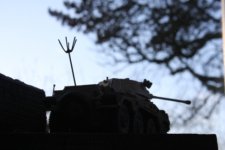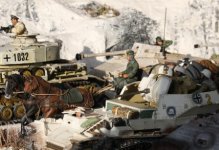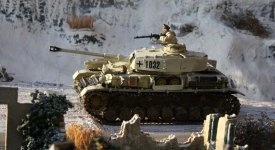panda1gen
Colonel
- Joined
- Jul 29, 2005
- Messages
- 8,162
b. ARMORED CAR PATROLS.
The Panzer division dispatches armored reconnaissance units equipped with armored vehicles and numerous automatic weapons. The armored reconnaissance unit is fast and has a wide radius of action.
Armored car patrols normally are composed of three armored reconnaissance cars, one of which is equipped with radio. An artillery observer often accompanies the patrol so that in an emergency fire can be brought down quickly. This type of patrol usually is organized for missions lasting one to two days. Tasks are defined clearly, and nothing is allowed to interfere with the patrol’s main objective. If enemy forces are met, action is avoided unless the force is so weak that it can be destroyed without diverting the patrol from it's main task. If enemy action is anticipated, the patrol is reinforced with self-propelled guns and occasionally with tanks. Engineers and motorcyclists are often attached to the patrol to deal with road blocks and demolition’s.
While scouting a woods, a favorite German ruse is to drive the leading car towards it's edge, halt briefly to observe, and then drive off rapidly, hoping to draw enemy fire that will disclose the enemy positions.
At road blocks, the leading car opens fire. If fire is not returned, men dismount and go forward to attach tow ropes to the road block. If necessary, the patrol dismounts and proceeds with machine guns to reconnoiter on foot.
A patrol is never split up, but in open country distances between cars may be as much as 200 to 300 yards.




The Panzer division dispatches armored reconnaissance units equipped with armored vehicles and numerous automatic weapons. The armored reconnaissance unit is fast and has a wide radius of action.
Armored car patrols normally are composed of three armored reconnaissance cars, one of which is equipped with radio. An artillery observer often accompanies the patrol so that in an emergency fire can be brought down quickly. This type of patrol usually is organized for missions lasting one to two days. Tasks are defined clearly, and nothing is allowed to interfere with the patrol’s main objective. If enemy forces are met, action is avoided unless the force is so weak that it can be destroyed without diverting the patrol from it's main task. If enemy action is anticipated, the patrol is reinforced with self-propelled guns and occasionally with tanks. Engineers and motorcyclists are often attached to the patrol to deal with road blocks and demolition’s.
While scouting a woods, a favorite German ruse is to drive the leading car towards it's edge, halt briefly to observe, and then drive off rapidly, hoping to draw enemy fire that will disclose the enemy positions.
At road blocks, the leading car opens fire. If fire is not returned, men dismount and go forward to attach tow ropes to the road block. If necessary, the patrol dismounts and proceeds with machine guns to reconnoiter on foot.
A patrol is never split up, but in open country distances between cars may be as much as 200 to 300 yards.































